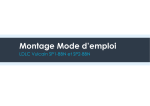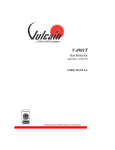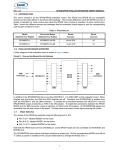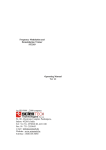Download VA-201M - Lev Co
Transcript
To r o n t o . O t ta w a . M o n t r é a l London . Windsor. Edmonton 1-888-862-5356 E-mail: [email protected] www.lev-co.com VA-201M Gas Monitor USER’S MANUAL Vulcain Alarm Inc. All Rights Reserved DR0015 December 2002 WARRANTY Vulcain Inc. warrants to the original purchaser that its product, and the component parts thereof, will be free from defects in workmanship and materials for a period of one year from the date of purchase. Vulcain will, without any charge and at its option, repair or replace defective products or components upon their delivery to its Repair and Service Department. This warranty does not apply in the event of misuse or abuse of the product, or as a result of unauthorized alterations or repairs. Vulcain shall not be liable for any consequential damages, including, without limitation, damages resulting from loss of use. Every precaution for accuracy has been taken in the preparation of this manual. However, Vulcain neither assumes responsibility for any omissions or errors that may appear, nor liability for any damages that may result from the use of the products in accordance with the information contained in this manual. Call Sales/Technical: 800-563-2967 Fax: (450) 632-9938 BEFORE RETURNING ANY INSTRUMENTS, PLEASE CONTACT US TO OBTAIN A RETURN OF MATERIAL AUTHORIZATION NUMBER. To obtain warranty service, return the product, along with a complete description of the defect, transportation prepaid. Vulcain assumes no risk for damage in transit. Following warranty repair, the product will be returned to the buyer, transportation prepaid. Warranty Registration To validate the warranty, this registration form must be completed in full and sent to Vulcain within 90 days of the date of purchase. Customer’s name: Address: City: Location of the installation: Serial no.: Vulcain Alarm Inc. All Rights Reserved State/Prov.: 1 DR0015 December 2002 TABLE OF CONTENTS WARRANTY ...............................................................................................1 TABLE OF CONTENTS ............................................................................2 UNPACKING...............................................................................................3 DESCRIPTION............................................................................................3 INSTALLATION GUIDELINES...............................................................3 DETERMINATION OF NUMBER OF SYSTEMS.................................4 SURFACE-MOUNT INSTALLATION ....................................................5 RANGE AND ALARM LEVELS.................................................................6 DUCT-TYPE INSTALLATION ...................................................................7 DUCT-TYPE MOUNTING DETAILS.........................................................8 ELECTRICAL WIRING ............................................................................9 REMOTE SENSOR CONFIGURATION (Optional) ..............................10 SPECIFICATIONS .....................................................................................10 PERIODIC INSPECTIONS AND CALIBRATION ................................11 USER INTERFACE ....................................................................................11 TESTING PROCEDURE ...........................................................................12 ADJUSTMENTS..........................................................................................12 TIME DELAYS............................................................................................12 RELAY OUTPUTS......................................................................................13 FIRST LEVEL (Alarm A) .............................................................................13 SECOND LEVEL (Alarm B) ........................................................................13 DETECTION PARAMETERS......................................................................13 OPTIONAL DISPLAY..................................................................................13 Vulcain Alarm Inc. All Rights Reserved 2 DR0015 December 2002 UNPACKING After opening the package, remove the equipment and components. Make sure that you have all the items described on the order form or packing slip. DESCRIPTION The VA-201M-Series is an advanced microprocessor-based system featuring a high quality standalone monitor, a unique high-tech enclosure, and all necessary characteristics to provide continuous, effective and fully integrated monitoring of toxic and combustible gases. INSTALLATION GUIDELINES Make sure to locate the monitor and sensing assembly(ies) in an area easily accessible to a technician. Avoid any location where the monitor could be subject to vibrations. Avoid any location close to noisy equipment. Avoid any location where temperature variations occur rapidly. Verify all the local requirements and existing regulations which may affect the choice of location. For the DT Duct-Type housing, installation is recommended on a straight duct at least 3 feet (1 m) away from any curve. Vulcain Alarm Inc. All Rights Reserved 3 DR0015 December 2002 DETERMINATION OF NUMBER OF SYSTEMS The number of transmitters required is determined by a unit’s operational radius of surveillance. Using Table 1 below, the number of units required can be easily evaluated. Table 1: Gas Detected CO NO2 Carbon Monoxide Nitrogen Dioxide Others Vulcain Alarm Inc. All Rights Reserved Radius of Surveillance Area Covered 50 feet (17 metres) 10,000 square feet (1,000 square metres) 20 feet (7 metres) 1,600 square feet (100 square metres) 4 DR0015 December 2002 SURFACE-MOUNT INSTALLATION Installation of the monitor simply requires the physical mounting of the enclosure and connection of the power and output lines. Table 2: Recommended Height Detected Gas Relative Density (air = 1) Height CO Carbon Monoxide 0.968 1 - 1.5 m (3 - 5 feet) from floor * NO2 Nitrogen Dioxide 1.58 (cold) H2 Hydrogen 0.07 30 cm (1 foot) from ceiling CL2 Chlorine 2.50 30 cm (1 foot) from floor NH3 Ammonia 0.59 30 cm (1 foot) from ceiling H2S Hydrogen Sulfide 1.19 30 cm (1 foot) from floor HCL Hydrogen Chloride 1.30 30 cm (1 foot) from floor HCN Hydrogen Cyanide 0.932 30 cm (1 foot) from floor ETO Ethylene Oxide 1.50 30 cm (1 foot) from floor O2 Oxygen 1.43 1 - 1.5 m (3 - 5 feet) from floor SO2 Sulfur Dioxide 2.25 30 cm (1 foot) from floor R11 R12 R22 R123 R125 R134A Refrigerants 5.04 4.20 3.11 5.27 4.14 3.52 30 cm (1 foot) from floor COMB Most combustibles are heavier than air, with the exception of methane, hydrogen, ethylene and acetylene. For gases that are heavier than air, sensors should be installed approximately 30 cm (1 foot) from the floor. For combustibles that are lighter than air, sensors should be installed 30 cm (1 foot) from the ceiling, close to the potential leak source. 30 cm to 1 m (1- 3 feet) from ceiling * May differ in certain applications. Hot NO2 from exhaust systems is lighter than ambient air. Vulcain Alarm Inc. All Rights Reserved 5 DR0015 December 2002 RANGE AND ALARM LEVELS Table 3: Range and Alarm Levels Gas Detected Range Alarm Level A Alarm Level B CO Carbon Monoxide 0 - 250 PPM 35 PPM 200 PPM NO2 Nitrogen Dioxide 0 - 10 PPM 0.72 PPM 2 PPM CL2 Chlorine 0 - 15 PPM 0.5 PPM 1 PPM NH3 Ammonia 0 - 100 PPM 25 PPM 35 PPM H2S Hydrogen Sulfide 0 - 50 PPM 10 PPM 15 PPM HCL Hydrogen Chloride 0 - 50 PPM 3 PPM 4 PPM HCN Hydrogen Cyanide 0 -50 PPM 5 PPM 9 PPM ETO Ethylene Oxide 0 - 10 PPM 1 PPM 5 PPM O2 Oxygen 0 - 25% Vol. 19.5% Vol. 22% Vol. SO2 Sulfur Dioxide 0 - 10 PPM 2 PPM 5 PPM R-123 Refrigerant 0 - 1000 PPM 50 PPM 500 PPM 0 - 1000 PPM 0 - 2000 PPM 250 PPM 1000 PPM 500 PPM 2000 PPM 0 - 100% LEL 25% LEL 50% LEL R-11 Refrigerants Q1 R-12 Q2 R-22 R-125 R134A Combustibles When the level of alarm has been reached, the corresponding relay will remain activated for a minimum of 59 seconds. A different alarm level may have been programmed in order to satisfy the constraint of a particular application. Vulcain Alarm Inc. All Rights Reserved 6 DR0015 December 2002 DUCT-TYPE INSTALLATION The VA-201M can be duct-mounted. It is most efficient when air speed is between 500 and 4,000 ft/minute (2.5 to 20.3 m/sec), and can be installed either for fresh air or exhaust monitoring. Make sure to verify all the requirements and existing regulations which may affect the choice of its location. We recommend installation on a straight duct at 1 m (3 feet) away from any curve. 1. Post the drilling guide to the ventilation duct. 2. Drill the openings for the sampling tubes. 3. Insert the sampling tube with lateral air holes in the appropriate connector, orienting the air holes facing airflow. Tighten with the (8-32 5/16”) screw on the connector. 4. Insert the exhaust tube into the appropriate connector, orienting the slant away from airflow. Tighten with the (8-32 5/16”) screw on the connector. 5. For a ventilation duct longer than 20 inches (51 cm), extra tubing is necessary. It is preferable to drill a hole at the opposite side facing the detection unit to support the far end of the tube. Seal the end of the tube with the cork supplied. If necessary, seal the openings on the duct around the tubings. 6. Install the box on the duct. 7. Connect the power and the outputs as shown in the ELECTRICAL WIRING section. 8. Before mounting the cover of the sampling unit box, start the ventilation feeding fan and check if there is any leakage. If necessary, seal with air plugs. 9. The cover should be mounted using metallic screws (6/32 1/2”). To convert from CFM to velocity (ft/minute), divide the flow by the area. Example: In a 2 ft X 4 ft duct, where the area is 8 ft2 and a CFM of 40,000, the air velocity will be 40,000 ft3/minute/(8 ft2) = 5,000 ft/minute Vulcain Alarm Inc. All Rights Reserved 7 DR0015 December 2002 DUCT-TYPE MOUNTING DETAILS Vulcain Alarm Inc. All Rights Reserved 8 DR0015 December 2002 ELECTRICAL WIRING Power Supply: Input J3 17 to 27 Vac, 24 to 38 Vdc, 250 mA Relay First Level: Output J1, 5 A, 30 Vdc or 250 Vac (resistive load) Relay Second Level: Output J2, 5 A, 30 Vdc or 250 Vac (resistive load) Vulcain Alarm Inc. All Rights Reserved 9 DR0015 December 2002 REMOTE SENSOR CONFIGURATION (Optional) Master Board O N 1 2 3 4 5 6 Cable Gauge: 18 AWG J2 Maximum Length: 100 feet (30 m) J3 Vulcain S4 Remote Sensor Assembly J1 J2 TP51 P51 TP52 P52 SPECIFICATIONS Power Requirements 17 - 27 Vac, 24 - 38 Vdc, 250 mA Operating Temperature Range 32oF to 100oF (0 to 40oC) Operating Humidity Range 0 to 95% RH (non-condensing) Outputs 2 DPDT optional relay 5A, 30 Vdc or 250 Vac (resistive load) Dimensions 8.4 in(H) x 5.3 in(W) x 2.25 in(D) (21.3 cm x 13.4 cm x 5.7 cm ) Weight 0.77 lbs (0.350 kg) Vulcain Alarm Inc. All Rights Reserved 10 DR0015 December 2002 PERIODIC INSPECTIONS AND CALIBRATION Calibration should be performed twice a year. More frequent calibration may be necessary for units operating under extreme conditions or exposed to contaminants or gas concentrations greater than the lower explosive limits. A calibration inspection must be included as part of routine maintenance to ensure proper operation of the gas detection unit. If unit span or zero cannot be adjusted, the sensor may be approaching its end-oflife or has been contaminated and must be replaced. USER INTERFACE After powering ON the monitor, the first 2 red LEDs will blink for 2 minutes during the warm-up period, followed by the green LED indicating normal operation. The yellow LED indicates a system failure. If this situation occurs, you should contact your local representative for further assistance. Each red LED represents 10% of the scale. For example, an oxygen depletion monitor reading 21% will light 8 red LEDs. When the gas concentration reaches the first alarm level (Alarm A), the second red LED from the top blinks and the first level relay is activated. If the gas concentration reaches the second alarm level (Alarm B), the first red LED from the top will blink. The second level relay and audible alarm are activated. When the gas concentration exceeds the scale, all red LEDs flash ON and OFF. For oxygen depletion detection only, the first level relay and audible alarm are activated when the concentration exceeds 22.0% and is less than 19.5%. In this case, relay 2 is never activated. Stabilization time depends on the type of sensor used. Typically, most of the VA-201M-Q1 Series stabilize within a few minutes, except for HCL, HCN and ETO units which stabilize fully in 7 days. VA-201M-Q2 Series and VA-201M oxygen units will need a minimum of 24 hours before reading within their specifications. Vulcain Alarm Inc. All Rights Reserved 11 DR0015 December 2002 TESTING PROCEDURE Flow a Span gas at the recommended rate and observe the action of the LEDs and analog outputs. Span gas can be purchased through your local representative. ADJUSTMENTS The VA-201M comes as plug and play out of the box. Field adjustement is possible. All adjustments are factory set. If required, consult the additional information below for verification of the time delays and relay output. TP1: For Relay Adjustment DIP1 TIME DELAYS Switch 4 and 5 of DIP1 determine the time delay set prior to and after activation of the alarms. Table 4: Time Delay Settings on DIP1 Switch 4 0 Min OFF Vulcain Alarm Inc. All Rights Reserved 1 Min OFF 5 Min ON 12 10 Min ON DR0015 December 2002 Table 4: Time Delay Settings on DIP1 Switch 5 0 Min OFF 1 Min ON 5 Min OFF 10 Min ON RELAY OUTPUTS The relay outputs are set at alarm levels based on the type of gas to be detected. Table 3 on page 6 indicates the alarm levels. The alarm level settings can be modified as follows: FIRST LEVEL (Alarm A) Connect a voltmeter to TP1 Pin 3 (+) and Pin 6 (-). Adjust P1 to Vdc = (Alarm level A x 4/scale of reading) Example for a VA-201M-CO: Vdc = (35 x 4/250) = 0.56 Vdc SECOND LEVEL (Alarm B) Connect a voltmeter to TP1 Pin 2 (+) and Pin6 (-). Adjust P1 to Vdc = (Alarm level B x 4/scale of reading) Example for a VA-201M-CO: Vdc = (200 x 4/250) = 3.2 Vdc DETECTION PARAMETERS Table 5: Alarm A Actions Alarm B Actions OPTIONAL DISPLAY An LCD display is available in order to visualize the gas concentration directly on the monitor. Toxic gases appear in parts per million, flammable gases in percentage of lower exposure limit, and oxygen in percentage per volume. Vulcain Alarm Inc. All Rights Reserved 13 DR0015 December 2002























